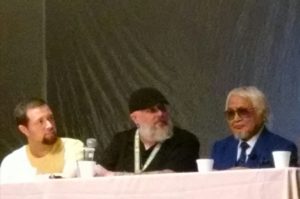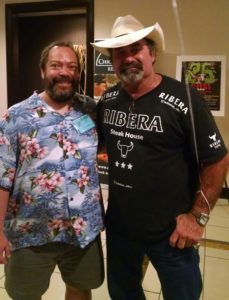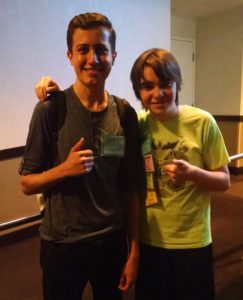G-Fest Brings Two Countries Together
For this summer’s trip to G-Fest in Chicago, we decided to fly instead of drive. No one had the time for an extended vacation like the one last year. We flew on Frontier airlines, which let me add to my Frontier mascot collection on Facebook.
G-Fest is an annual convention held in the U.S. that celebrates kaiju, the giant monsters of Japanese film. The most famous of these monsters, of course, is Godzilla, whose storied franchise began in 1954, not long after the end of the Second World War. Through this film genre, the Japanese people have processed the utter helplessness and massive urban destruction they experienced at the hands of the United States during the war.
Despite the experience of the war, there is actually an affinity between Japan and the U.S. that goes back to the years before then, perhaps best exemplified by American baseball star Babe Ruth’s visit to Japan in 1934. In the post-war years, it shows in the extent to which Americans have embraced aspects of Japanese culture, such as anime. It’s connected to the story of how Japan was the first non-Western nation to adopt Western ways and become an economic powerhouse, both in the industrial age before the war, and in the information age afterwards.

G-Fest is relatively small as geeky conventions go, but it has all of the trappings one would expect from such an event – cosplay, gaming, art both amateur and professional, merchandise, discussion panels, and special guests. This year marked the convention’s 25th anniversary – G-Fest XXV – and a review was published in the Chicago Tribune, which has lots of pictures from the costume contest, evidence of the heart that people put into their fandom.

The affinity between our two nations really shines at G-Fest, where you can see the love that American fans have for the veteran Japanese actors and film technicians who appear as guests of the convention. It shows in the money raised by auctioning vintage art and memorabilia in support of the victims of Japan’s recent flooding disaster. It’s almost as though Americans are doing penance for the destruction their ancestors caused.

As I watch this interchange, I can’t help but think that these movies were all made during the American Century, when the U.S. was the leader of the free world, and defended Japan in exchange for Japan’s promise not to arm itself offensively. This was an arrangement made as part of the Japanese surrender in WWII, but as a new age emerges, it is being called into question. Will our relationship change in the future?
There is a G-fest tradition of going to see movies specially chosen for the event at the nearby Pickwick theater. This year we saw Rampage (neither the worst nor the best monster movie ever made) and as I watched the mutated creatures smashing there way through Chicago I reflected on how the United States is still processing 9/11. We are still trying to find our way in the 21st century.

As the American Century winds down, the special bond we share with Japan thanks to kaiju is sure to remain. For one, the young generation has picked it up. There are many young fans, sustaining a cottage industry on YouTube of homegrown films in the genre. The platform is only a decade old, but for the young generation, it is as meaningful as any other medium.
And Godzilla lives on, rebooted in the new MonsterVerse franchise. The monster suits have been replaced by CGI, but the spirit is the same. The next movie in the series will be out in the summer of 2019. I’m sure it will be all anyone is talking about at G-Fext XXVI.
